Abstract
The plasma protein binding of theophylline was measured in 21 patients with renal disease and 21 healthy age and sex matched controls. The percentage of theophylline unbound to plasma was greater in patients with nephrotic syndrome and in chronic renal failure than in controls. In nephrotic syndrome the impairment of drug binding mirrored the marked degree of hypoalbuminaemia seen in this condition but in chronic renal failure the impairment of protein binding was greater than would be expected from the plasma albumin concentration changes. The percentage of theophylline free in plasma in renal disease may be increased (by as much as 50%). Such changes should be taken into account in interpreting the relationship between total plasma theophylline concentration and drug effect in renal disease.
Full text
PDF


Selected References
These references are in PubMed. This may not be the complete list of references from this article.
- Buss D., Leopold D., Smith A. P., Routledge P. A. Determinants of the plasma protein binding of theophylline in health. Br J Clin Pharmacol. 1983 Apr;15(4):399–405. doi: 10.1111/j.1365-2125.1983.tb01521.x. [DOI] [PMC free article] [PubMed] [Google Scholar]
- DUNCOMBE W. G. THE COLORIMETRIC MICRO-DETERMINATION OF NON-ESTERIFIED FATTY ACIDS IN PLASMA. Clin Chim Acta. 1964 Feb;9:122–125. doi: 10.1016/0009-8981(64)90004-x. [DOI] [PubMed] [Google Scholar]
- Ebden P., Leopold D., Smith A. P., Buss D., Routledge P. A. Free and total plasma theophylline concentrations in chronic airflow obstruction. Thorax. 1984 May;39(5):352–355. doi: 10.1136/thx.39.5.352. [DOI] [PMC free article] [PubMed] [Google Scholar]
- Grossman S. H., Davis D., Kitchell B. B., Shand D. G., Routledge P. A. Diazepam and lidocaine plasma protein binding in renal disease. Clin Pharmacol Ther. 1982 Mar;31(3):350–357. doi: 10.1038/clpt.1982.45. [DOI] [PubMed] [Google Scholar]
- Gugler R., Azarnoff D. L. Drug protein binding and the nephrotic syndrome. Clin Pharmacokinet. 1976;1(1):25–35. doi: 10.2165/00003088-197601010-00003. [DOI] [PubMed] [Google Scholar]
- Kradjan W. A., Martin T. R., Delaney C. J., Blair A. D., Cutler R. E. Effect of hemodialysis on the pharmacokinetics of theophylline in chronic renal failure. Nephron. 1982;32(1):40–44. doi: 10.1159/000182729. [DOI] [PubMed] [Google Scholar]
- Losowsky M. S., Kenward D. H. Lipid metabolism in acute and chronic renal failure. J Lab Clin Med. 1968 May;71(5):736–743. [PubMed] [Google Scholar]
- Sjöholm I., Kober A., Odar-Cederlöf I., Borgåa O. Protein binding of drugs in uremic and normal serum: the role of endogenous binding inhibitors. Biochem Pharmacol. 1976 May 15;25(10):1205–1213. doi: 10.1016/0006-2952(76)90370-1. [DOI] [PubMed] [Google Scholar]
- Sternberg J. C. A rate nephelometer for measuring specific proteins by immunoprecipitin reactions. Clin Chem. 1977 Aug;23(8):1456–1464. [PubMed] [Google Scholar]


